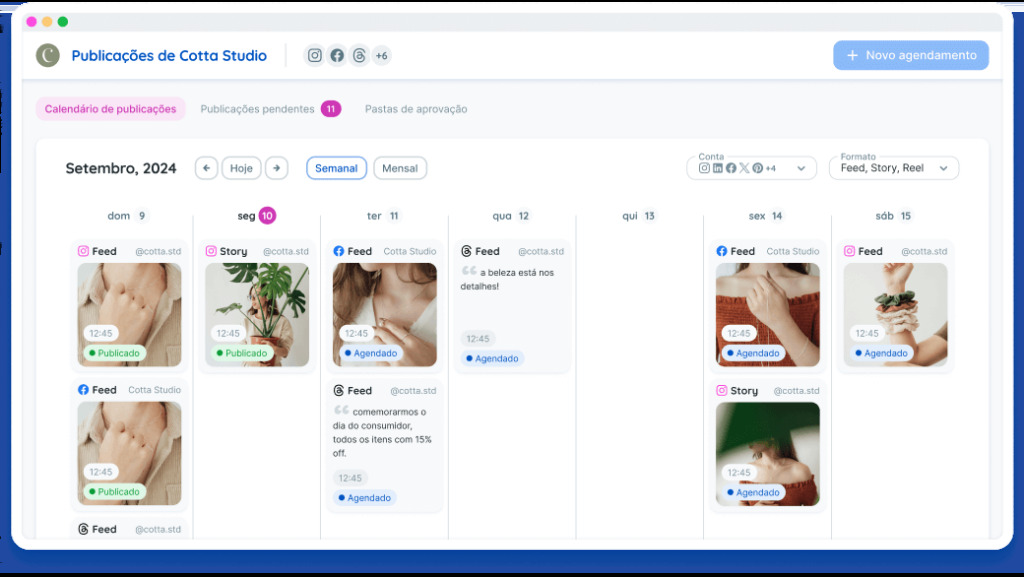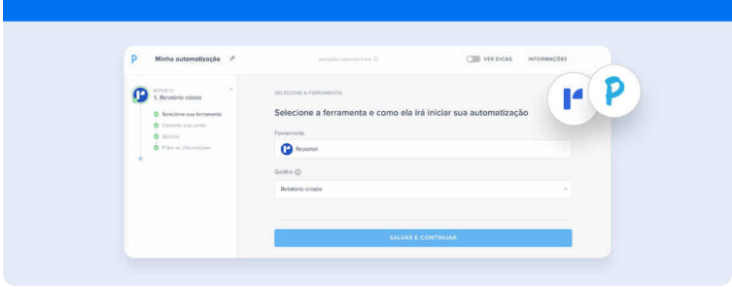Having a posting schedule to guide content production on social media is one of the most effective ways to ensure organization, variety, and frequency of posts.
That’s why we’ve prepared this article specifically to help you create a model in just 6 steps, considering the ideal tool, the channels used, the posting frequency, among other important points. Continue reading to check it out.
Why create a posting schedule for social networks
Before we talk about the tips for creating a good posting schedule for social networks, it’s essential to remember the importance of this tool for your digital marketing strategy.
As they aim to generate engagement with the public and strengthen the relationship, social media like Instagram, Facebook, TikTok, and X, for example, need to be constantly updated with relevant content.
Thus, planning the posts becomes essential so that, besides ensuring recurrence, you provide solutions to your persona with various topics and take advantage of the different formats each social network offers.
This way, you prevent your profiles/pages from becoming mere sales channels and focus on more interactive, informative, and valuable communication for your followers.
Learn how to create your posting schedule in 6 steps
Now that you know why a posting schedule is essential for your social media actions, it’s time to start structuring yours. Check out useful tips for your daily routine below.
1. Choose a tool to build the posting schedule
A social media posting schedule needs to be, above all, visual, easy to identify the ready content and track them.
Many marketing professionals use Excel or Google Sheets to structure this calendar, creating layouts that highlight the most important information such as publication date, editorial brief, content briefing, among other points that will be addressed in the following topics.
However, there are more practical ways for this construction.
Here comes Reportei Flux, which allows organizing the entire posting calendar in a collaborative environment. It’s also possible to schedule content for Instagram, Facebook, LinkedIn, TikTok, and much more without needing to use different platforms.

2. Organize the content according to the channels used
If using different social networks is part of your strategy, it’s important to organize your content according to the channels and the formats each one allows.
If you’re using a spreadsheet as a tool, for example, you can leave a separate tab for each media. This way, you avoid any confusion and have a broader view of the actions planned and developed each month.
In Reportei Flux, you can separate the content by channel within the calendar, clearly visualizing where each piece will be published.
3. Guide your planning through editorials
For your posting schedule to be effective, you need to have space for the editorials that guide the topics covered in your content.
They will help you work with variety and avoid having the publications be too repetitive.
Below are some editorials that are commonly worked on in social networks
- Tips and tutorials
- Promotion of products/services
- Institutional
- Promotion of blog articles
- Commemorative dates
4. Keep an eye on the calendar and references
Speaking of commemorative dates, good post planning should consider the most important days for the business because they create a greater connection with the audience.
From traditional dates like Christmas, New Year, and Easter to more specific ones or events held by your company/client, you have the option to create content to honor, educate, or interact with users.
In addition, whether for posts on commemorative dates or other editorials, remember to look for references that help make the topics more interesting and innovate in your content.
5. Establish the posting frequency
Having regularity in your posts is essential not only to keep the audience informed and updated but also to increase the reach of the profile/page. If there’s no defined frequency, the social network will increasingly give less prominence to your content.
To help with this aspect, leave space in the schedule layout to determine the publication date and also the production deadlines for each post.
Reportei Flux helps you in this process because
- It allows identifying production and approval deadlines
- It offers a visual calendar to plan the ideal frequency
- With AI support from Reportei, you receive suggestions for the best publishing times based on analysis of your audience’s behavior. In other words, besides planning, you publish at the most strategic time to enhance performance.
→ Read also Content creation: how to have a routine that doesn’t rely on improvisation
6. Regularly monitor the status of your content
After all, there’s no point in creating an organized schedule and not keeping the status of the posts always updated, right?
So be sure to create a column specifically to track the production progress, asking the team to always fill this area with what is yet to be done, what has already been produced, and what has been published.
This ensures more organization, less rework, and total transparency between team and client.
How Reportei Flux assists with your posting schedule
Reportei Flux goes beyond a simple calendar
- Multichannel post scheduling Instagram, Facebook, TikTok, LinkedIn, Google My Business, and much more
- Integrated approval workflow where clients approve posts directly on the platform
- Centralized feedback without needing emails, screenshots, or spreadsheets
- Time suggestions via AI to optimize results
- Organized publication history enabling subsequent strategic analyses
In conjunction with Reportei reports, Flux forms a complete digital marketing ecosystem uniting analysis, strategy, and execution in one place. Try Reportei for free and create Digital Marketing and Sales Reports and Dashboards in just 3 seconds!



